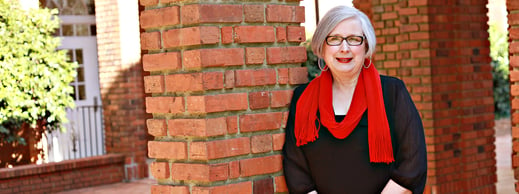
January 15 2019
From Joanne Soliday, "PIVOT" co-author and higher education veteran
"For most of my career, I have been intensely involved in helping colleges and universities take incremental steps toward health. The nine elements of the Thriving Framework®, explicated in my earlier book Surviving to Thriving: A Planning Framework for Leaders of Private Colleges and Universities, were all conceived because of their critical importance to the growth and sustainability of the colleges and universities I knew so well.
We know that action-oriented planning techniques are crucial, and that telling the story of an institution with distinction can make the difference in presenting the strength of its value proposition. Strong revenue streams, active and engaged learning, and campus spaces that encourage commitment and belonging are also markers of a thriving institution. The right use of data and modeling are central to everything above. And, in order to make it all happen, there is a compelling need for courageous leadership that results in culture change and greater levels of institutional self-esteem. I still believe it all! As I have contemplated what connects each of these elements to the future, I believe there is a new need to examine what thriving will mean as higher education changes.
It just isn’t enough anymore for an institution to think about small, incremental growth steps to thriving. Every college is going to have to reexamine its ability to change direction in significant ways with courage, speed, and agility over the next ten years. As readers know well, the obstacles to change come in many forms. Sometimes the leadership team and board of trustees of the institution are not unified and healthy enough to inspire a culture of excitement and trust that will allow risk-taking. In other situations, the leadership team and the board might be ready to go, but the relationship between the faculty and administration needs deep repair. I, like you, could describe many specific situations representative of this challenge, but in the end, the ability to change is rooted in institutional culture. Everything Mark and I have written in this book will be dependent upon the shape of that culture. There simply isn’t going to be a strategy that is strong enough to live in a culture of mistrust, apathy, or siloed thinking.
Over nearly twenty-five years in higher education consulting, questions about culture have arisen consistently in hundreds of my interactions. In exhaustive interviews and hundreds of strategy sessions, we almost always come around to culture as an obstacle to change. The conversations always begin with presidents asking about critical issues: How can issues in enrollment be solved? How can my advancement staff position me correctly to do the kind of fundraising necessary over the next years? What does student success really mean, and how can it be designed in a way to increase our retention rate and meet our mission? Of course, these are important and strategic questions. But quickly, we begin to see together that somewhere at the root of all these issues is the slow, subconscious flow of culture, informing the way we work and interact every day in ways we do not explicitly recognize, putting up barriers at so many turns to the strategies that will ultimately be critical to the future success of the institution and its students.
It is my hope that all of you reading this book and blog series will embrace the pivot points for which we advocate in these pages and will give careful thought to the multifaceted challenges and opportunities accompanying such change. These pivots require more, though, than shifts in operations or programs or business practices or even ways of leading—they require your commitment as institutional leaders to cultural change around accountability, agility, trust, appreciation, risk-taking, and individual learning and development. Maybe most of all, they require a spirit of self-awareness. You must be able to identify the gifts you can bring to bear—specific to your personal experience, leadership style, and character—on your own institutional culture in order to give wings to the implementation of pivotal change."
-
Learn more about Joanne Soliday and look for our next "Pivot" blog focusing on how to create a shared vision between the President and the Board.
© Credo and www.credohighered.com, 2018. Unauthorized use and/or duplication of this material without express and written permission from this site’s author and/or owner is strictly prohibited. Short excerpts and links may be used, provided that full and clear credit is given to Credo, Credo Press, and www.credohighered.com with appropriate and specific direction to the original content. Please email info@credohighered.com for information on how to obtain a full copy of Pivot: A Vision for the New University or for permission to use excerpts from the book and/or blog series.
Related Blog Posts
Recent Posts
- Richard Dunsworth, J.D., To Receive 12th Annual Courageous Leadership Award December 16 2024
- Meet the 2024 Credo Values Award Recipients August 27 2024
- What is Executive Coaching, Really? June 25 2024
- Credo & The Constructive Dialogue Institute Announce A New Partnership For Higher Education Leadership Development March 7 2024
- Celebrating Women And Gender-Diverse Learners & Leaders February 28 2024
Categories
- Strategy
- Leadership
- Student Success
- Student Success & Retention
- Enrollment
- Pivot
- Strategic Planning
- Leadership Development
- News
- Strategic Enrollment
- Campus Planning and Architecture
- Moving the Needle
- Data
- Research
- Retention
- Campus Master Planning
- Enrollment & Financial Aid
- Academic Programming
- Campus Planning
- Thriving
- Admitted Student Research
- Architecture
- Finance
- Advising
- Admissions




